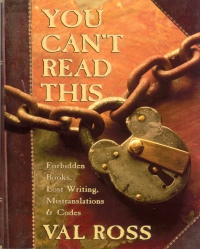| ________________
CM . . .
. Volume XII Number 20 . . . .June 9, 2006 
 |
You Can’t Read This: Forbidden Books, Lost Writing, Mistranslations & Codes.
Val Ross.
Toronto, ON: Tundra Books, 2006.
140 pp., cloth, $26.99.
ISBN 0-88776-732-X.
Subject Headings:
Books and reading-History-Juvenile literature.
Reading-History-Juvenile literature.
Prohibitied books.
Grades 5 and up / Ages 10 and up.
Review by Ronald J. Hore.
***½ /4 |
| |
|

excerpt:
With a murderess author and a publisher who was a notorious radical with feminist connections, it's easy to see why Tales from Shakespeare was presented with less than the whole truth. But what about the other book? What dark mystery kept the real author of The Family Shakespeare a secret? What could possibly be as bad as revolutionary politics, feminism, or murder?
At the front of The Family Shakespeare's first edition, an anonymous preface explained that the author was trying to serve "those who value every literary production in proportion to the effect it may produce in a religious or moral point of view...." The author had "omitted many speeches in which SHAKESPEARE has been tempted to purchase laughter at the price of decency." With all the cheap laughs censored, said the writer, the plays could safely be read by "young persons of both sexes." Over the next few years, it leaked out that the book was the work of Thomas Bowdler, a retired doctor of strong religious beliefs. After The Family Shakespeare appeared, Dr. Bowdler's name eventually became so well known that it turned into a verb. "To bowdlerize" means to prudishly mutilate a text, to delete all the bits you disapprove of."
The subtitle of You Can’t Read This tells us what to expect inside the covers: Forbidden Books, Lost Writing, Mistranslations & Codes. Arranged in chronological order, the chapters lead the reader from ancient Mesopotamia to modern Afghanistan and the Taliban in 2001. An easy read at 125 pages, plus another 15 pages of notes, acknowledgements and an index, this is a compact 7.25" x 9.25" book that would be of interest to lovers of history, mystery and the written word.
Written by a storyteller, the information is presented in a style that makes it easy to follow and, what is probably more important, makes it interesting to the reader discovering these stories for the first time. While written for children ages 10 and up, their parents will also find it informative and well worth reading.
The book is divided into an Introduction, followed by 18 short chapters. The first chapter, “The First Readers,” starts with Mesopotamia, told as a picture of everyday life. The next chapter, “Language Lost and Language Found,” tells the story of the search for the lost civilizations of Crete and their mysterious language. Chapter three, “The Poet and the Emperor,” describes the dangerous life of the poet Lucan during the reign of the Roman Emperor Nero. In chapter four, “The Made-to-Order Alphabet,” we learn of one man's efforts to create a special alphabet so his people could become literate. Chapter five, “The Prayerful Pagodas,” takes us to Japan and the world's first great publishing effort. In chapter six, we are up to the year AD 1009, and in “The Stolen Story,” we hear about the problems faced by women authors in China. The destruction of some of the world's greatest books is described in chapter seven, “The Pillage of Baghdad.” Chapter eight, “Giving Books to the People,” brings us to the fifteenth century and the discovery of printing in two widely separate parts of the world. In chapter nine, “Darkness Upon the Deep,” we read about the attempts to suppress printing in order to keep books from the common folk. By chapter ten, “The Cousins and the Code,” we are reading about codes used during Elizabethan times and the men who discover their secrets. Chapter eleven, “Books Not to be Read,” describes books that were banned, sometimes for all the wrong reasons. By chapter twelve, we are up to “That Dreadful Mr. Shakespeare” and the attempts by some people to edit his work. Chapter thirteen, “A Book at His Fingertips,” tells the story of Louis Braille and his efforts to find a way for blind people to enjoy reading. Chapter fourteen describes the story of Frederick Douglass in “Freddy the Slave Boy” and his struggle to bring reading to the black slaves in the United States at the time of the American Civil War. In Chapter fifteen, we learn about the problems that can arise when a treaty is translated into a different language in the story of the New Zealand Maoris in” The Two-Faced Treaty.” By chapter sixteen, we are up to the twentieth century and the story of “The Evil World of - Comic Books?” Chapter seventeen brings us up to date with “Days of the Taliban” and the problems faced by girls who want to learn how to read. The final chapter, “Access Denied,” takes us into the world of codes and computers.
Adding to the enjoyment of this volume are 33 black and white pictures and illustrations varying in size from a quarter page up to a full page.
These stories describe the power of the written word. Although written in simple and straightforward language, the book will appeal to a wide range of readers.
Highly Recommended.
Ronald J. Hore, involved with writer's groups and writer's workshops for several years, retired from the business world in Winnipeg, MB.

To comment
on this title or this review, send mail to cm@umanitoba.ca.
Copyright © the Manitoba Library Association. Reproduction for personal
use is permitted only if this copyright notice is maintained. Any
other reproduction is prohibited without permission.
NEXT REVIEW |
TABLE OF CONTENTS FOR THIS ISSUE
- June 9, 2006.
AUTHORS |
TITLES |
MEDIA REVIEWS |
PROFILES |
BACK ISSUES |
SEARCH |
CMARCHIVE |
HOME |
